
MI6, THE SPY IN THE IRISH POLICE FORCE, JACK LYNCH AND BRITAIN – AN INSIGHT INTO ANGO-IRISH RELATIONS A YEAR AFTER BLOODY SUNDAY
Ed Moloney & Bob Mitchell with a piece throwing light on the nature of British Irish relations after the war crimes of Bloody Sunday. It initially featured on The Broken Elbowon 26 January 2014.

The British government’s archive at Kew has, thanks to the ferreting of my colleague Bob Mitchell, produced a document that sheds fascinating light on the nature of the relationship between the British and Irish governments a year or so after Bloody Sunday, when the killing of fourteen unarmed civilians at a civil rights demonstration in Derry by the 1st Parachute Regiment pitched Anglo-Irish relations into their gravest crisis since the creation of the Irish state.
Those of us who were alive at the time can never forget the huge wave of anger and sympathy for Northern Nationalists that rolled through the South in the ensuing days. Factories and workplaces throughout the country came to a standstill as thousands of people staged impromptu strikes and marched to town centres carrying placards condemning the British. Buses and trains stopped running, Aer Lingus planes were grounded and the government recalled the London ambassador in protest.

A victim of the Paras’ violence on Bloody Sunday is carried away
Not since partition had Southern and Northern Nationalism been so united, and not since the Anglo-Irish war of 1919-1921 had there been such anti-British fervor in Ireland, and it all culminated in a massive protest outside the British embassy in Dublin during which the building was burned to the ground. A gelignite bomb blew down the embassy’s solid Georgian door and soon petrol bombs rained through the opening. A crowd estimated at 20,000 cheered as the flames consumed the building and stopped fire engines getting near the inferno.

A huge crowd gathered outside the British embassy in Merrion Square, Dublin to protest at the Bloody Sunday killings
The Guardian reported:
Hatred of Britain in the Republic reached fever pitch as the embassy’s interior blazed fiercely, watched by several thousand. ‘Burn, burn, burn,’ they shouted as chunks of masonry and woodwork fell blazing onto the street. They redoubled their cheering whenever they saw the fire breaking through into new parts of the building.Symptomatic of Nationalist anger at the slaughter was the response of the normally cautious and moderate John Hume, a leader of the pro-Irish government SDLP who said sentiment in his area was now: “It’s a united Ireland or nothing”. But those expecting all this to be reflected in a more aggressive stand towards the British on the North by the government in Dublin, then led by Fianna Fail chief Jack Lynch, were to be disappointed. A seminal article by Eamon McCann in the Irish Times in January 2012, written to mark the 40th anniversary of Bloody Sunday, describes how, whatever the ordinary people of Ireland felt, the dominant emotion in establishment circles was nervousness at the boost all this could give to the IRA and the alarming consequences there might be for political stability in the Southern state. Irish prime minister Jack Lynch betrayed his inner fears in a late night phone call to British prime minister, Edward Heath just hours after the guns had fallen silent in Derry. One account of the conversation quoted him saying:
“’……from reactions received from around the country at the moment it looks as if a very serious point has now been reached, and the situation could escalate. . . my role is becoming more and more difficult, and I am very, very fearful of what is likely to happen. I just want to tell you how gravely apprehensive I am.’”

Jack Lynch
The account continued:
“Lynch apologised to Heath for ringing him so late….the apology ‘set the tone for the conversation, with Lynch timidly trying to express his apprehensions while an irritated Heath blamed the marchers for the deaths and Lynch for not doing more to combat republicans.’”In the days and weeks following Bloody Sunday the southern political mainstream mobilised against the IRA, making it clear that the Provisionals were now considered a threat to the southern as well as the northern state. Lynch’s government quickly announced plans to recruit an extra 600 policemen and warned that it might introduce special courts to try IRA members. The British ambassador, Sir John Peck had complained that before Bloody Sunday juries would “frequently” refuse to convict IRA suspects but afterwards that it was “impossible” to secure a guilty verdict. To Peck’s satisfaction, the juryless Special Criminal Court was established in May 1972, four months later and soon began to jail IRA suspects unimpeded by the pro-nationalist perspective from the jury room.
The day after the funerals of the Bloody Sunday victims, Lynch had issued a warning to the IRA during a speech to the Irish parliament: “The institutions of this State will be upheld without fear or favour. The laws will continue to be enforced. Those who seek to usurp the functions of government will meet with no toleration.” His Justice Minister. Des O’Malley ordered the retrial of IRA suspects acquitted on arms charges and the government’s toughening line against the IRA was endorsed by opposition parties in the Irish parliament. At the government party’s ard-fheis, or annual conference, held three weeks after Bloody Sunday, Lynch’s aides successfully prevented any motion on Bloody Sunday or the North being debated. Arrests of leading Provisionals started in March and in May, the head of Sinn Fein, Ruairi O Bradaigh and former Belfast Brigade commander, Joe Cahill were jailed.
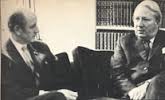
British prime minister Ted Heath (r) meets Jack Lynch
As McCann wrote:
The North had seemed as never before to have become a visceral reality in the South. But literally within days, alarmed at the appalling vista suddenly revealed in the mood and scale and class composition of the demonstrations, in the burning of the embassy and the strut in the step of republican paramilitaries, the main parties of nationalism emotionally and intellectually disengaged from the North and resolved to come down hard on any elements that in the name of the North dared challenge the integrity of the Southern State.Bloody Sunday has often been described as a prodigious boon to the IRA, which it undoubtedly was; recruitment to the organisation soared afterwards and with its ranks swollen the IRA was able to make 1972 the most violent year of the Troubles. But it was also a turning point for the British as well, for the other consequence was that afterwards London and Dublin united against the IRA with a new determination and agreed a political strategy – support for constitutional nationalism, a power-sharing government in Belfast and a cross-Border mechanism of some sort – that not only survived the subsequent decades but emerged triumphant on Good Friday, 1998.
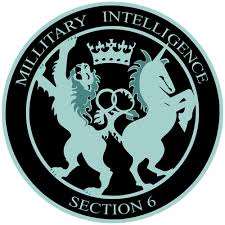
In the post Bloody Sunday atmosphere, MI6 launched an operation to recruit spies in the Irish police force
Given the Irish establishment’s alarm at the national mood after Bloody Sunday, it would have been surprising if British intelligence had not concluded that this might be a propitious time to step up its activities against the IRA south of the Irish Border. After all it was now clear that the two governments were at one in their hostility to the IRA; and who in the Dublin government and security apparatus could seriously object? And so some time in 1972, when exactly we don’t know, MI6 dispatched one of its agents, East African-born, John Wyman (36) with an address at Swan Walk in Chelsea, London to Dublin with instructions, it seems, to recruit sources inside the intelligence sections of an Garda Siochana, the Irish police force. From reports of interviews with Garda detectives later it seemed he had made several trips and had meetings with a number of “contacts” in hotels. His cover was that he was recruiting staff for a security firm based in Oxfordshire, England, which in a way was true.
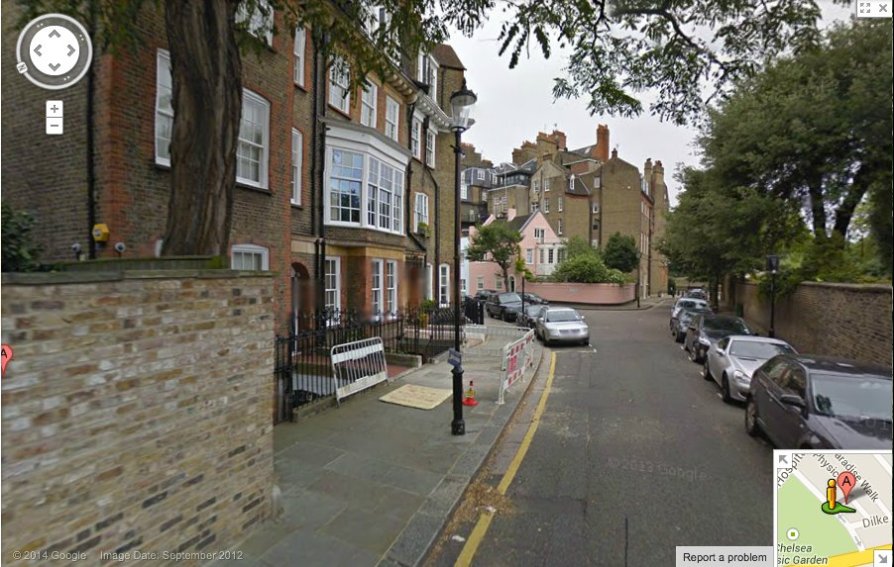
A street scene in Swan Walk, Chelsea, the fashionable address given by John Wyman. This is a screen grab from a Google maps street view.
We know the name of only one of his contacts, 38-year old detective Patrick Crinnion (his name was sometimes spelled Crinion in contemporary reports), a registry clerk with C3, a specialist counter terrorism group that is part of the Special Branch, based at Garda headquarters in Phoenix Park. Crinnion was an ideal source for a group like MI6 because his job in C3’s archive gave him access to a treasure trove of intelligence documents. There was a great irony here. During the Anglo-Irish war, IRA leader Michael Collins was given access by police sympathisers to the British intelligence archive in Dublin Castle; some fifty years later MI6 had, courtesy of a sympathetic policeman, gained similar entreé to the Irish government’s intelligence repository.
Whether Wyman had recruited other spies in the Irish governmental system to work for MI6 is not known but it certainly seems possible; both his interrogators and the Irish government suspected he had. He was arrested in late December 1972 at the West County Hotel in Chapelizod, west Dublin where he had arrived by car and was waiting in the hotel car park, as if to meet someone. He was staying in an hotel miles away in the south of the city, the Burlington, where he had made an arrangement to meet Crinnion later on the night he was arrested, so the trip to the West County raises obvious questions.
Exactly how the Irish police got on to Wyman was never explained. When he was arrested he was told it was because he was suspected of belonging to a proscribed organisation; but MI6 was not banned in Ireland. Citing this as a cause for his arrest might have been a ploy by the Irish police but it does raise the interesting possibility that Wyman was also meeting IRA members who had been under Garda Special Branch surveillance and had himself come under suspicion. The West County hotel was, because of its convenience to those travelling into Dublin from the west of Ireland, favoured by republicans as a meeting place; the hotel was where IRA dissidents met in 1986 after a split in the Gerry Adams-led Sinn Fein over dropping abstentionism to form Republican Sinn Fein. Gardai evidence given later in court suggested that they did not know about Crinnion before Wyman’s arrest although this could have been a subterfuge to hide methods or sources. The Irish police claimed they got on to him when they searched Wyman’s hotel room and found an unsigned note, apparently pushed under the door, re-arranging that night’s meeting with Wyman for the following evening.

Detectives waited in Wyman’s room for the MI6 man’s mysterious visitor the following night and arrested Crinnion when he turned up. When Crinnion and his captors reached the hotel’s ground floor, he tried to flee to his car but got only 40 yards when he was brought to the ground and taken to the Bridewell for questioning. A search of his vehicle led to the discovery of ten documents hidden under the carpet behind the passenger seat and more documents, all from C3’s files, were found at his home in Kilmacud.
Although Wyman initially maintained to his Garda interrogators that he was an English businessman visiting Ireland to vet potential employees, he soon admitted that he was “an agent of a British Minister” and told one Special Branch detective that he and they were “in the same line” of work. A notebook in his possession indicated that he was especially interested in finding the source of rocket launchers that had come into the IRA’s hands. For his part, Crinnion said he had met Wyman six times but later reduced this to three. So, an intelligence agent from a supposedly friendly neighbour and ally had been caught red-handed suborning an officer in a sensitive counter terrorist police unit who had been induced to hand over valuable documents to a foreign government; to add to this, the agent responsible had very possibly recruited other spies elsewhere in the Irish government.
In such circumstances most governments on the receiving end of such flagrant espionage would react with controlled outrage. It might be going too far for one ally to expel another’s diplomats, as happened regularly between the Soviet Union and Western powers at this time – and since they were bitter ideological foes that was to be expected – but few governments could allow such a thing to pass by without a considered and proportionate response. That, at least initially, appeared to be the Irish government’s posture on the matter, according to an intriguing document recently unearthed at Kew. The document is a three page account of a thirty minute meeting about “the Wyman incident” between Robert Armstrong, the principal private secretary to the then British prime minister Ted Heath and the Irish ambassador to London, Dr Donal O’Sullivan on December 23rd, 1972, just five days after Wyman’s arrest. The document, which is erroneously headed 23 December 1973 but further down gives the correct year, 1972, is marked “Message No 3” and was addressed to Heath at Chequers and marked “Top Secret and Personal”.
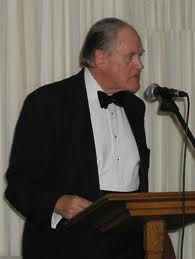
Robert Armstrong, Heath’s principal private sceretary
Britain’s ambassador to Dublin at this time was Foreign Office veteran Sir John Peck who was himself no stranger to the byzantine world of intelligence. In the 1950’s Peck had helped turn the Foreign Office’s Information Research Department (IRD) into an anti-Soviet black propaganda agency which fed material via sympathetic journalists to the BBC World Service and Third World media outlets. In the early 1970’s the IRD was very active in Northern Ireland funneling anti-IRA propaganda to the media, paralleling the work of the British Army’s Information Policy Unit then staffed by the likes of Colin Wallace. Around December 20th, 1972, two days after John Wyman’s arrest, the Irish Foreign Minister, Dr Patrick Hillery met Sir John Peck in Dublin to discuss the matter who then reported back to Downing Street. After reading Peck’s report, Ted Heath had called in the Irish ambassador to tell him of his concerns arising from that meeting; the ambassador had then travelled to Dublin to report Heath’s unease to Jack Lynch and on December 23rd he arrived back in Downing Street to tell Robert Armstrong the result of his meeting with the Irish premier.

Ireland’s Minister for Foreign Affairs at the time of ‘the Wyman incident’, Dr Patrick Hillery
At the heart of British concerns was a comment from Hillery to Peck that the discovery of an MI6 agent at work in Dublin meant that relations between the two countries were now “back to square one”. The remark, implying Ireland’s loss of trust in the British, indicated a level of anger in official Irish circles at the affair that the detached observer might not consider inappropriate. But it soon became clear that Dr Hillery was speaking only for himself, not his prime minister. Jack Lynch’s priority was still the same as the British: the defeat of the IRA. And so the Irish prime minister denied outright that Hillery had ever said such a thing even though, as Armstrong noted, Peck’s report “had specifically quoted” exactly the same words, “back to square one”; but O’Sullivan maintained that Lynch’s record of the Peck-Hillery encounter made no mention at all of the phrase, and he added:
“….Mr Lynch had asked him to assure the prime minister that there was no question of this on his side. He did not wish the present level of relationships to be impaired in any way. The Irish government had welcomed the British government’s agreement to discuss the Irish dimension and the Council of Ireland and hoped that nothing would interfere with that situation.”And so in a single paragraph we can see expressed the Irish government’s priority in the wake of Bloody Sunday: the agreement of political structures that would help isolate and defeat the Provisionals. That was what mattered in Dublin and to underscore how important it was to the Irish state that friendly relations with the British be maintained, the ambassador even offered, on the day before Christmas Eve, to travel all the way from Downing Street in central London to the Buckinghamshire countryside to deliver Lynch’s message in person to Ted Heath at Chequers should Heath wish it. He was politely declined.
The Irish ambassador had further reassurances from Lynch to deliver to Downing Street. Asked by Armstrong whether the Wyman incident might imperil cross-Border security co-operation, Dr O’Sullivan gave this assurance: “There was no intention or desire that these contacts should be in any way impaired:, adding: “….Mr Lynch was very anxious that his own relationship with the prime minister should not in any way suffer as a result of this incident.” It is clear from Armstrong’s account that the Irish government was as concerned about “the public relations” downside of the affair as anything else. The phrase “public relations” appears three times in Armstrong’s account of the Irish ambassador’s concerns and it is evident by the repeated use of the phrase that the Irish side was concerned that the IRA could exploit Wyman’s arrest for propaganda purposes.
While MI6 had infiltrated the Irish police and may have recruited other, unknown agents, causing untold damage to the integrity of the state’s security apparatus, the fact that the IRA might enjoy a public relations fest appeared to be of greater import in Dublin. And although there was evidence from the interrogation of the MI6 agent and his Garda spy about “others who might be involved”, the Irish side also seemed more exercised by the fact that the information passed to Wyman by Crinnion was not exclusively concerned with the IRA; some of the material found in Crinnion’s car, O’Sullivan complained, were C3 documents “unrelated to the IRA” that had not yet been seen by the Minister of Justice. Had Crinnion’s documents dealt only with the IRA, the Irish government, it appeared, might not have been so concerned. Strikingly, nowhere in Armstrong’s account does the Irish ambassador seek an assurance on Jack Lynch’s behalf that the British will desist from any further intelligence operations on Irish soil. Rather much of the remaining conversation between Robert Armstrong and Ambassador O’Sullivan touched upon the legal treatment Britain’s MI6 agent might receive in Ireland. While the ambassador told Armstrong that the Irish government could not interfere in the working of the justice system, he went on to hint that it might do exactly that, as Armstrong explained in his message to Heath:
“I have not included in the note the two points which were for your eyes only: “For public relations reasons his (O’Sullivan’s) government would have to oppose bail; but the strength with which they would do so was another matter. “You had expressed concern about the effects of a long sentence. He (O’Sullivan) had the impression that this was unlikely; indeed he said there might be no sentence at all.”Wyman and Crinnion appeared at the Special Criminal Court in Dublin in January and February 1973 and were charged under the Official Secrets Act with passing secret information prejudicial to the safety or preservation of the State, charges that brought up to seven years imprisonment.
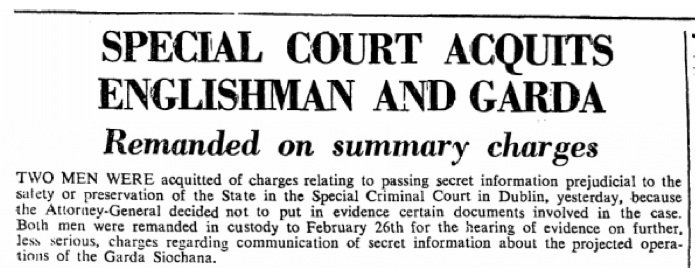
The pair did not get bail, as the ambassador hinted they might, and they were held in isolation for their own safety at Mountjoy jail in north Dublin. But, as Dr O’Sullivan had apparently predicted, neither man would serve a single day in jail for their crime; in fact they were acquitted of the most serious charge thanks to an extraordinary move by Ireland’s Attorney-General, Colm Condon, the son of a former Fianna Fail Senator. The entire trial was held in secret, in camera, and reporters were banned from the courtroom. Newspaper accounts were sparse and repetitive and nothing that transpired during the trial was made publicly known. Despite this cloak of secrecy, Condon refused to allow the judges to see the documents at the heart of the case, the C3 papers which had been found in Crinnion’s car. Since the documents would prove one way or another whether the security of the Irish state had been threatened by their disclosure to the British, the judges, deprived of critical evidence, had little option except to acquit both men. Condon had the power himself to admit the documents, the judges would have read them in secret and none of their contents would ever be made public. But the decision to conceal the documents, made by a political ally of Lynch and his predecessor Sean Lemass, ensured that the MI6 agent would be acquitted and the Irish government spared an embarrassing conflict with the British just a few days before the terms were agreed for political talks on the North’s future, talks that would include the Council of Ireland, the institution which Lynch’s government believed would undermine support for the IRA.
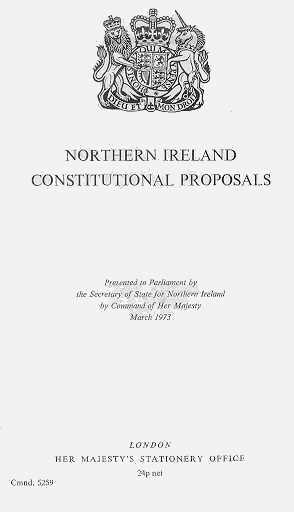
A British White Paper on the future of Northern Ireland, published within days of the acquittal of John Wyman and Patrick Crinnion, accepted that the Irish dimension, in practice a Council of Ireland, would be on the agenda for political talks. Securing this pledge lay behind Lynch’s reluctance to confront Britain over MI6′s espionage in Ireland.
A week or so later, Wyman and Crinnion were tried on lesser charges of communicating information about Garda operations and on these they were found guilty and sentenced to six months jail. This trial was held in public and although basic facts about the case became known in consequence, C3′s documents were kept secret. Since they had already served three months on bail and qualified for remission both men were immediately released and left Ireland for Britain, with Crinnion’s lawyer bitterly complaining that his client could never set foot in his native country again. Here is the Armstrong message to Ted Heath followed by an intriguing postscript:
Wyman 1 by emol_74903278
Wyman 2 by emol_74903278
Wyman 3 by emol_74903278
Nearly four years after the arrests of John Wyman and Patrick Crinnion and their trials, a six paragraph story appeared in the Irish Times which showed that “the Wyman incident”, as the two governments called it, was still reverberating strongly through the Irish police force. The story appeared on October 26th, 1976 and was by-lined ‘Irish Times Reporter’:
Wyman by emol_74903278
Posted in: Anglo Irish Relations,Feature from Elsewhere
marty says:
3:39 PM, February 13, 2014Reply
After reading this excellent post I for one would not be in the least surprised to find that the government in the Dail were implicit in the murder of its citizens in the Dublin and Monaghan bombings,their cringing attitude to the illegal activities of the brits is nothing short of the quisling behaviour of quisling $inn £eind,the only difference is that those who infest the Dail are/were supposed to be a sovereign government.they must have laughed their balls off in Whitehall at the cowardice and grovelling of those so called Irish wankers.
Owen Sullivan says:
6:02 PM, February 13, 2014
All unambiguous evidence of an imperial vassal state relationship proving once again that the so called southern "Free" State is nothing more than a Vichy statelet sponsored and directed by a foreign power via native complicity. What little time the British spy Wyman and his Irish traitor Crinnion served was for public relations reasons only. As in occupied France the Resistance is punished while the Vichy go free.
sean bres says:
8:50 PM, February 13, 2014
Absolutely sickening to read that, the slave mentality of the Irish establishment and their need to be patted on the head by the colonial master is saddening and indeed angering. Almost humiliated to be an Irishman reading that... Very painful
Niall says:
8:30 AM, February 14, 2014
It never ceases to amaze me when talking to people how naive they are when it comes to the activities of the British Intelligence services - they all seem to think that the activities of these secret service groups stops at the door of Irish Republicanism......it's quite astonishing how many unwittingly hold this view....and any attempt to remove the cataracts can be quite exhausting...
Away from Republicanism for it is too easy to see this in operation with them, if we take a close look at certain members of the SDLP and their activities you'll see a pattern develop that calls for further scrutiny...the so called 'Anne's Law' is just a recent one. Backed by and publicly pushed for, by a long-term member, which succeeded in its passing but resulted in the removal of an up and coming leading light by the leadership for betrayal (with the excesses of Stormont, did anyone really believe that the rat was removed for accounting errors!!!)...Wasn't it extraordinary how this long-term member crawled out from under his rock and began to demand that his party support Unionism on this point....who called him out to publicly embarrass the leadership in to a u-turn and look what happened to the poor patsy who was the tool...and tool being the optimum word...but who called the patsy and the long-term

No comments:
Post a Comment